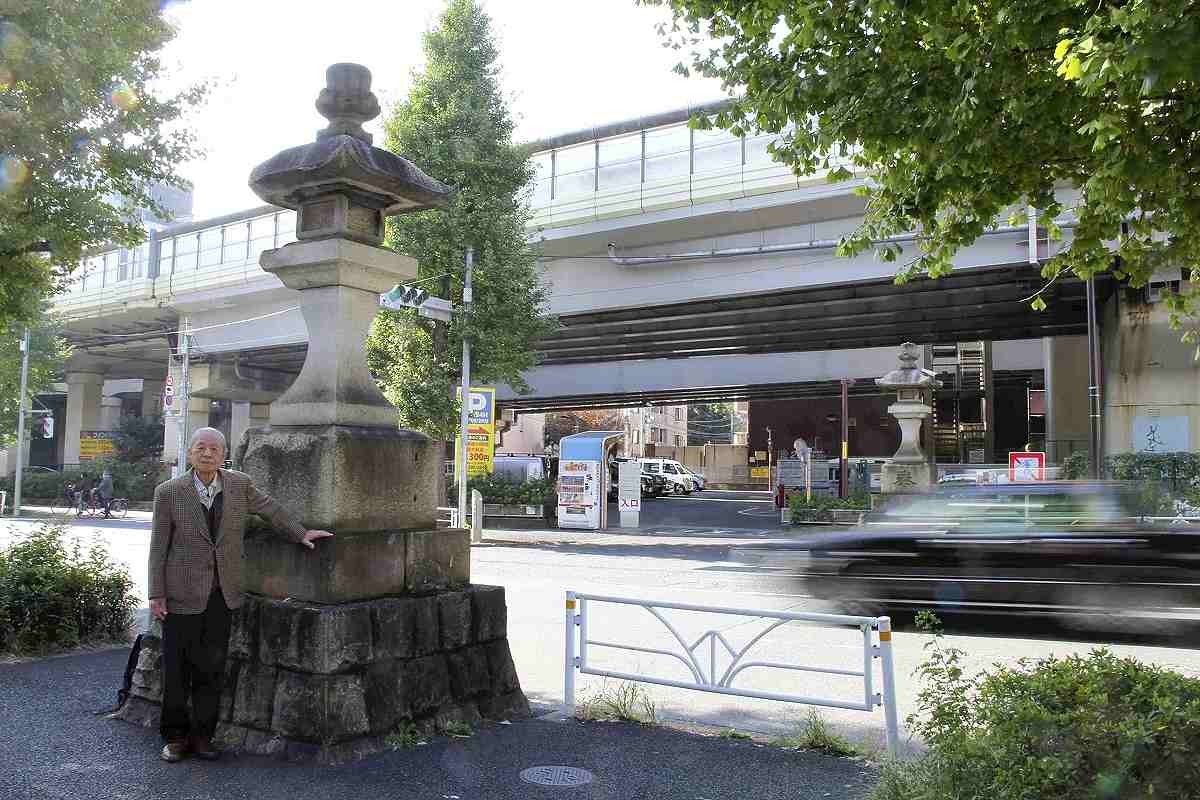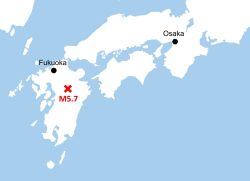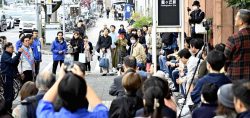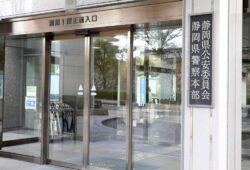100 Years of Meiji Jingu / Area West of Shrine Eyed for Revitalization

District association head Takashige Kunieda stands by an old street light on Nishisando in Shibuya Ward, Tokyo, on Nov.17. The space under the expressway behind Kunieda is scheduled to be redeveloped.
The Yomiuri Shimbun
13:42 JST, December 5, 2020
This is the third and final installment of a series on the Meiji Jingu shrine in Shibuya Ward, Tokyo, which marked its centenary last month. The shrine has been renovated for the occasion.
***
A straight, two-lane street hugs the tracks northwest of the Odakyu Line’s Sangubashi Station in Shibuya Ward, Tokyo. Towering toro street lights built just before Meiji Jingu shrine was completed in 1920 stand on opposite sides of the street about 600 meters from the station.
These lights mark the start of Nishisando, a road that leads to the shrine. The Metropolitan Expressway’s No. 4 route, which was built for the 1964 Tokyo Games, runs overhead.
“Many years ago, stalls were open here for New Year, but now it’s much less lively,” said Takashige Kunieda, the head of a local district association. Kunieda, 88, lives near Nishisando.
Before Meiji Jingu was built, Nishisando was called Jusangen-doro and linked the Koshu Kaido route with the Minami Toshima Imperial Estate and the Yoyogi military exercise ground. In 1914, the Keio Line’s Yoyogi Station was built at the intersection of Nishisando and the Koshu Kaido. This station was later renamed Jinguura Station and then Nishisando Station.
The Koshu Kaido was lined with many shops selling bread, tabi Japanese socks, liquor, medicine and other goods. However, Nishisando Station closed in July 1945 and many shops were demolished to make way for the widening of the Koshu Kaido. Apartment buildings and office buildings were constructed in the district, but there were fewer pedestrians.
Omotesando is probably the best-known of the major roads that approach Meiji Jingu. After World War II, the Washington Heights housing complex for U.S. military personnel and their families was built in part of what is now Yoyogi Park. This ushered in the arrival on Omotesando of many clothing stores and other shops for Americans. The road now brims with the boutiques of international brands.
Omotesando, which was built when Meiji Jingu was constructed, originally was a gravel road. Many of Omotesando’s famous zelkova trees were burned down during wartime air raids, but local landscaping businesses replanted them after the war and the road was widened. In the 1990s, the sidewalks were paved with granite.
According to Harajuku Omotesando Keyaki-kai, a shopping district promotion association in charge of developing Omotesando, in recent years the most pressing issue has been that the road’s zelkovas have grown too big and some have become diseased. The Tokyo metropolitan government has replaced trees that were at risk of toppling.
“It might be a good idea to gradually replace a few trees every year, so they all get replaced over 60 years,” suggested Seiichi Matsui, 69, head of the association.
From the next fiscal year, Shibuya Ward will redevelop the area around Nishisando. One plan being floated would see the asphalt on the sidewalks replaced with granite paving, which is used on many paths that lead to shrines.
The ward government also intends to more effectively use space under the elevated expressway that runs along Nishisando. It plans to turn a site used for storing abandoned bicycles into a new facility for cultural and other social events. After signing an agreement with the Japan Shogi Association this year, one vision for the new facility would see it hosting shogi Japanese chess classes and tournaments.
Development of an area encompassing three Keio New Line stations — Sasazuka, Hatagaya and Hatsudai — also is under consideration. This project aims to create more of a community in this heavily populated area and give the local economy a shot in the arm. The ward government has hosted workshops of a “Sasa-Hata-Hatsu council” — a title formed from the first two katakana letters of the three stations’ names.
The centerpiece of this plan is the redevelopment of a pathway that follows the Tamagawa Josui historic canal. The about 2.6-kilometer path follows the railway line between Sasazuka and Hatsudai, and it is dotted with play equipment, toilets and bicycle parking areas. Some local residents have requested the creation of water features where children can play and a barbecue space. The ward government will examine whether such options are possible without harming natural greenery along the path.
“Omotesando has undergone dramatic change over the past century, as Western influences were added to traditional Japanese culture,” Shibuya Ward Mayor Ken Hasebe said. “Next I want to inject some more life into Nishisando.”
Popular Articles
Popular articles in the past 24 hours
-

Japanese Public, Private Sectors to Partner on ¥3 Tril. Project t...
-

Japan, China Continue Trading Barbs Over Radar Incident; Tokyo Re...
-

Japanese Lawmakers Support Continued Ban on Sports Betting
-

JAXA Stops Rocket Launch Broadcast amid Engine Issues
-

JAXA Launches 8th H3 Rocket from Japan’s Kagoshima Pref.
-

Japan's Nikkei Stock Average Jumps on Weaker Yen, Renewed AI Opti...
-

Figure Skater Kaori Sakamoto Set to Compete at Olympics in Milan,...
-

Quake Beneath Tokyo: Utilize New Damage Estimates for Disaster Ma...
Popular articles in the past week
-

Israeli Tourists Refused Accommodation at Hotel in Japan’s Nagano...
-

U.S. Senate Resolution Backs Japan, Condemns China's Pressure
-

Kenta Maeda Joins Rakuten Eagles; Returns from American MLB to Ja...
-

Sharp Decline in Number of Chinese Tourists But Overall Number of...
-

China Attacks Japan at U.N. Security Council Meetings; Representa...
-

Japan Set to Participate in EU's R&D Framework, Aims to Boost Coo...
-

Japan Backs Public-Private Cooperation on Economic Security; Nati...
-

Bus Bound for Hokkaido's New Chitose Airport Catches Fire Wednesd...
Popular articles in the past month
-

Keidanren Chairman Yoshinobu Tsutsui Visits Kashiwazaki-Kariwa Nu...
-

Tokyo Economic Security Forum to Hold Inaugural Meeting Amid Tens...
-

Imports of Rare Earths from China Facing Delays, May Be Caused by...
-

University of Tokyo Professor Discusses Japanese Economic Securit...
-

Japan Pulls out of Vietnam Nuclear Project, Complicating Hanoi's ...
-

Govt Aims to Expand NISA Program Lineup, Abolish Age Restriction
-

Blanket Eel Trade Restrictions Rejected
-

Key Japan Labor Group to Seek Pay Scale Hike
"Society" POPULAR ARTICLE
-

M4.9 Earthquake Hits Tokyo, Neighboring Prefectures
-

Israeli Tourists Refused Accommodation at Hotel in Japan’s Nagano Pref., Prompting Protest by Israeli Embassy and Probe by Prefecture
-

M7.5 Earthquake Hits Northern Japan; Tsunami Waves Observed in Hokkaido, Aomori and Iwate Prefectures
-

Tsukiji Market Urges Tourists to Avoid Visiting in Year-End
-

M5.7 Earthquake Hits Japan’s Kumamoto Pref., Measuring Upper 5 Intensity, No Tsunami Expected
JN ACCESS RANKING
-

Keidanren Chairman Yoshinobu Tsutsui Visits Kashiwazaki-Kariwa Nuclear Power Plant; Inspects New Emergency Safety System
-

Tokyo Economic Security Forum to Hold Inaugural Meeting Amid Tense Global Environment
-

Imports of Rare Earths from China Facing Delays, May Be Caused by Deterioration of Japan-China Relations
-

University of Tokyo Professor Discusses Japanese Economic Security in Interview Ahead of Forum
-

Japan Pulls out of Vietnam Nuclear Project, Complicating Hanoi’s Power Plans







